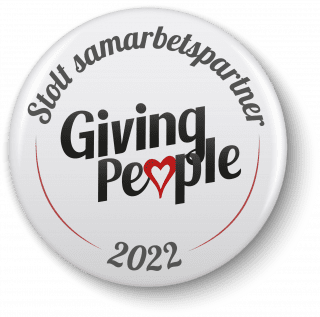Namibia is a sunny and very large country in southwestern Africa. Here you meet dramatic landscapes with giant sand dunes, beautiful resorts along the coast, some of the world’s best safari experiences in the north of the country and beautiful night skies out in the desert, where you feel very far away from wi-fi and coffee shops. Namibia is one of Africa’s most fascinating countries, a country that “God created in anger” as the locals say from time to time. Here you meet an impressive wildlife, with everything from beetles that survive in extremely dry desert areas to antelopes, elephants and desert lions.
Contact form
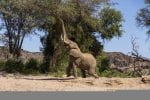
Ecorating: 3.0
This product meets our requirements for Ecorating, a product that is good for humans and the environment.
Does my trip make a difference?
Read more
This product meets our requirements for Ecorating, a product that is good for humans and the environment.
Sample Itinerary

Welcome to Namibia!
You land in Windhoek, the capital of Namibia. Your driver is waiting for you and will take you to your hotel. Relax and recharge your batteries.

Have a hearty breakfast at the hotel before heading out to the airport and the journey to The Dunes Lodge. The lodge is located on top of a sandy plateau with panoramic views in all directions. Here you enjoy the beauty of the desert on the first floor.

See the landscape from above in a hot air balloon, go on a flight safari to even more remote areas in the desert or go on a fantastic hiking safari and experience NamibRand up close. Only the imagination (and the budget) sets limits.
It does not matter if you move on land or in the air, nature and the area will give you unforgettable experiences and you will probably be amazed at how much life is hidden and thrives in this barren environment. Maybe you have a picnic out on a sand dune or drink a sundowner when the sun goes down, and in the evening a good candlelit meal awaits under the clear starry sky – a magical experience.
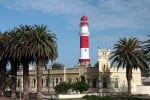
After breakfast in the camp, the journey continues with a small private plane to Swakopmund, along the way you can see the desert from the air, also a magnificent experience. The city is located between the Atlantic Ocean and the Namib Desert, and here you will meet the very special German-African culture with whimsical architectural elements. The city offers lots of atmosphere and some German “gemütlichkeit”.
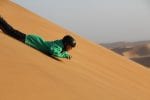
After breakfast we go on an adventure – or rather a game of sand boarding. It is not necessary to have tried it before. After a short introduction, we find a suitable sand dune and then it goes out there! After lunch we go on a boat trip from Walvis Bay, where we cross past places where you grow oysters and we enjoy the fresh air while we get closer to the destination of the trip – the seal colony at Pelican Point. Many different birds live here, such as pelicans, flamingos and cormorants. Possibly we also spot dolphins or whales.

After breakfast we say goodbye to Swakopmund to take the plane to Mowani Camp. You land in the heat and dust of the fantastic landscape which is Damaraland. Here awaits a little desert paradise – Mowani Mountain Camp. In the shadow of huge boulders is the camp, which is the starting point for the adventures and safaris of the coming days, which can either go along old, dried-up river sections, where life is hidden in places where you can least expect. Maybe you spot one of the rare desert elephants, springbok and chamois or a jackal. During the stay we also pass Twyfelfontein, where you can see rock engravings that are over 2,500 years old – with many of the animals that have lived here for millennia. Twyfelfontein is on the World Heritage List.
But here is also room to enjoy life: cool down in the pool, drink something cold when the day is over, eat a good dinner and feel how you get closer to nature and maybe even to yourself.

Enjoy life and the surroundings.
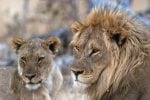
We say goodbye and move on to Anderson’s Camp in Etosha National Park. Etosha can be translated to “Land of Dry Water” or “Great White Place” and this is also an area of sand that changes into various white and silvery shades, whirlwinds and fata morganas. One of Africa’s best reserves, and especially in the driest part of the year, where large herds of animals can be seen in a spectacular and extremely photo-friendly landscape. Here you can sit for hours and just watch nature walk and calm pace.

Stand up with nature, watch the animals eat when the heat is not yet soothing and enjoy the silence. Lunch and siesta in the middle of the day, and a little later an afternoon safari.
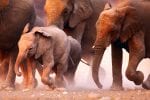
Breakfast in the camp and transport to Windhoek. Either you go straight home or maybe end up with a few nights in Cape Town, South Africa.
Trip details
Ecorating: 3
When can you travel?All year round but it can be very hot in December and January. The coldest are in June and July.
Airport: Windhoek (WDH)
Length: 10 nights
Price includes: International round-trip flight, full board at the safari lodges and breakfast at the hotel in Swakopmund, all activities in the program, transfer to and from the airport.
Price does not include: Travel insurance, tips, extra activities and meals outside the planned program.
Good to know about Namibia:
Mobile coverage and internet: Coverage in the larger hotels but not during your stay in the desert
Visas: Danish citizens do not need visa but your passport must be valid for a minimum of 6 months from entry. There must be at least two blank pages in the passport passport.
Time zone: GMT + 1
Vaccinations: Read more at Statens Serum Institut
Local currency: Namibian dollar
Weather: Windhoek, Namibia
Water: Clean water in the camp and in the hotels
Safety: Good

Ecorating: 3.0
This product meets our requirements for Ecorating, a product that is good for humans and the environment.
Does my trip make a difference?
Read more
This product meets our requirements for Ecorating, a product that is good for humans and the environment.
Nature care:
Mowani Camp has recently established a partnership with IRDNC (Integrated Rural Development and Nature conservation), AfriCat, EHRA (Elephant human relations Aid) and
Uibasen (Twyfelfontein) Conservancy for the purpose of caring for and protecting animals and nature in the area.
It supports a lion project in the desert, where Mowani and Kipwe pay one of the two rangers who keep an eye on the population.
A large number of local plants have been planted to strengthen biodiversity both at the lodge itself but also at the water hole. The water hole has also been dug a lot larger so that it can provide enough water for a herd of elephants of up to 18 individuals.
Local community:
Winter Knights and Medic Rush are projects where the elders of the tribe and children were given blankets and clothes, and where doctors and nurses visited Damaraland to provide care and medical assistance.
A football tournament is arranged four times a year, where, among other things, alcohol problems are mentioned.
Nearby farms are helped to feed their animals. A healthy pig or cow can make all the difference for a family.
Mowani helps local farmers maintain water holes, and helps repair water damage that elephant herds can cause.
The employees come almost exclusively from the local community.
You educate people from the local community in how to work with gardening, including budget work, long-term sustainability and in what order to plant things for over a number of years.
Recycling and waste management:
All waste is collected and sent to Windhoek for further handling.
Personnel policy:
Mowani currently has a managerial guide and an assistant coach. The two gentlemen came to the lodge 13 years ago and started as a laborer and servant, respectively. Over the last few years, 8 employees have been trained to a level where they can train new employees themselves. Experts have been used to train the staff working in the kitchen and with reception tasks.
Kitchen Garden:
Mowani has started his own herb garden, which the chefs are responsible for running. Herbs and vegetables are grown here.
Local suppliers:
Mowani also buys vegetables from Dimab, a community-run herb garden with the help of the lodge.
Energy:
Mowani uses low energy light bulbs. The lodge’s design has high ceilings and ventilation ducts, which means that you can keep the temperature down even during very hot days.



